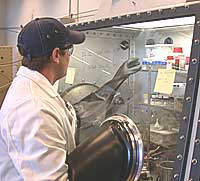Wires and Sensing Devices Made from Molecules
|
Conventional electronics focuses on developing ever smaller, faster processors and denser memories by etching increasingly fine features onto silicon. Molecular electronics -- electronic devices fabricated from molecular components -- by contrast, takes a bottom-up, building-block approach: It starts with the smallest unit (atoms) to build molecular assemblies as the platform to create high-density devices for computational applications or molecular sensing. The development of molecular electronics can extend the capabilities of silicon while keeping fabrication costs relatively low.
Molecular electronics research being conducted in Cliff Kubiak's lab in the Chemistry and Biochemistry Department at UCSD indicates that functionalized, conjugated organic molecules can provide mechanical linkages and aide electron transfer between nanoscale metal clusters and semiconductors. Kubiak says, "We believe that such components could provide electronic devices for chemical and biological sensing and recognition applications."
Kubiak has been able to measure conduction through a single molecule using a scanning tunneling microscope. The studies have demonstrated extremes of conductivity -- both high and low electrical resistances.
"In silicon technology, when the resistance is high," says Kubiak, "the solution is to 'dope' the silicon by adding a bit of an impurity, that is, an atom that contains one more or one fewer electron." Molecules generally cannot assume fractional charges, so the goal is to create a molecular charge-transfer (CT) complex.
Explains Dustin Siegel, a summer undergraduate research fellow supported through Calit² working in Kubiak's lab: "CT complexes are formed by the interaction of an electron donor molecule with an electron acceptor molecule. These are interesting because they are insulating as single molecules but conducting as bound complexes." CT complexes can conduct electrical current much more efficiently than either the individual donor or acceptor, due to high electron exchange. In one case, by using the CT complex strategy, the researchers achieved a 100-fold increase in conductivity of the CT complex relative to the individual donor molecule [J. Phys. Chem. B, 2002, in press].
These complexes can then be "written" onto silicon surfaces as conducting nanowires. The two molecules need to be chosen carefully because only a small percentage of molecules form CT complexes with high conductivity. "To study CT complexes for potential candidates as nanoscale electronic devices," says Siegel, "the complexes must be assembled onto a flat surface in a controlled manner. Ideal candidates are those that self assemble into a monolayer on the surface.
From nanowires, it's only a short step to creation of molecular sensors. Chemical and biological molecular sensors, integrated onto a semiconductor have potential application for nanoscale electrical devices. "By using molecules that bind to something you want to sense," explains Kubiak, "you can measure the relative presence of that substance by monitoring changes in the electrical resistance resulting from the chemical binding event."
Different metals have different affinities for binding various substances. For example, in a given "ligand" environment, iron has strong binding affinities for oxygen and carbon monoxide, while cobalt prefers nitric oxide. Based on these individual response functions, it is possible to develop an array of nanosensors (iron, cobalt, manganese, etc.) for "hyperspectral" simultaneous multi-component analysis of environmental gases.
This work is supported by a three-year, $1.56M DOE grant "Nanoscale Science and Technology of Environmental Sensors" and a $15M, five-year NASA grant "Institute for Nanoelectronics and Computing."
Related Links

